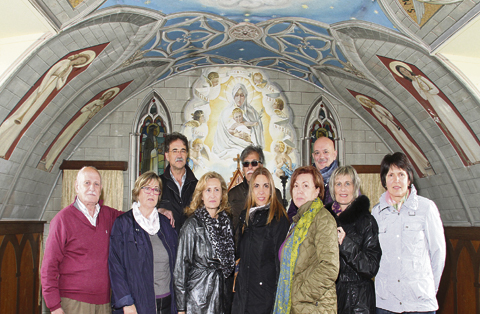August 29 | ![]() 0 COMMENTS
0 COMMENTS ![]() print
print

Looking back at a miracle
This summer marks the 70th anniversary of Orkney’s famous Italian chapel, often referred to as the ‘Miracle of Camp 60.’ Author PHILIP PARIS explains why a converted Nissen hut on a tiny uninhabited island is so important
Sometimes it is only by looking back at events, and at our lives, that we can see whether we are going in the right direction. This summer many of us have spent time ‘looking back’ because of the anniversaries connected to the First and Second World Wars.
It is also the 70th anniversary of the creation of an extraordinary monument to the human spirit’s ability to achieve greatness when faced with enormous hardship and despair. Such is the Italian chapel’s standing that during May Pope Francis sent a special blessing to mark the occasion ahead of an anniversary Mass that was celebrated by the Apostolic Nuncio to Great Britain and Archbishop Emeritus Mario Conti.
Over the last few weeks I’ve thought often of that day in August 2005 when I first entered the chapel along with my wife, Catherine. We were on honeymoon in Orkney and had absolutely no idea how this Second World War Nissen hut, converted with scrap material and leftover cement, would change our lives. The experience of that visit was so moving that I vowed to find out as much as I could about the events surrounding the chapel’s creation. This turned into a quest that consumed every spare minute I had for the next four years.
The basic facts were well publicised. At the beginning of 1942 around 550 Italian prisoners-of-war arrived on the tiny Orkney island of Lamb Holm. They had been transported from a PoW camp in Egypt, having been captured during the North African Campaigns, and were there to help build huge barriers, to seal the eastern entrances into Scapa Flow which was being used as a harbour for the British Home Fleet. Like Italians in many POW camps around the world, those on Lamb Holm built a chapel. But I wanted much more than basic facts. Behind Buttapasta’s stunning façade and Chiocchetti’s beautiful paintings there were stories of enemies and friendships, hope and hardship, despair and love. I wanted those stories because only with them came an understanding of the chapel, one that you can’t get from figures and dates.
Amongst the many things it represents, the chapel is a symbol of friendship and Catherine and I have made many close friends because of this journey. One of them is John Muir, secretary of the chapel preservation committee since the sixties and who provided the contact details for several of the descendents of the key artists behind the chapel and the men who ran Camp 60 in which it was built.
As time went on, the list of people to interview grew and grew… the 101-year-old daughter of the man who owned Lamb Holm during the Second World War, ex PoWs and their families… they all had a part of the chapel’s story or knowledge of what it was like to be a PoW in a strange country, and no-one had ever asked them before to tell it. There were so many amazing discoveries, secrets that had remained hidden since 1944. After four years I had followed every feasible avenue and had run out of questions to which I could find answers.
I told the story of the chapel in two totally different books, an historical fiction and a non-fiction. I thought my own involvement with the building would diminish following their publication, but I was wrong. I am often writing or speaking about it or I’m being contacted by someone wondering if I can provide information.
The chapel has inspired me in many different ways and I’ve recently written a stage play, Heart of the Chapel. I am now seeking a theatre company to take this to the next step. Earlier in the year I was delighted to be asked to be a consultant on a very exciting project, a feature film inspired by the chapel. The film script for The Melted Heart is being written by Glasgow-based Italian scriptwriter Inga Sempel and produced by Clive Leighton for Storm and Light Pictures. The director is Matteo Piccinini.
In June Catherine and I were back in Orkney for our annual holiday, this trip coinciding with a visit by several Italians who were there to mark the occasion of the 70th anniversary. This included the son and daughter of Domenico Chiocchetti, the key artist, and the daughter and granddaughter of Giuseppe Palumbi, the blacksmith who created the intricate wrought iron rood screen. None of the Palumbi family had ever been to Orkney so this was a particularly moving experience for them. Indeed, it would be fair to say there were tears all around on more than one occasion!
There was even a round table event about the building at Orkney’s prestigious St Magnus festival, which was started (completely unplanned) by 94-year-old Gino Caprara, who walked out from the audience, took over the chairman’s seat and recounted some of his memories of the time he spent as a PoW in Orkney.
The chapel’s fame grows every year. It is Orkney’s second most visited tourist attraction with around 100,000 people a year gazing upon the many wonders inside. The building crosses all boundaries of race and nationality, reaching out to us with a message of peace and hope from people now long gone. Many of their children and grandchildren have formed strong friendships because of what happened on a windswept island 70 years ago. As the son of one ex PoW said to me ‘the chapel is a moving, never-ending story’. He is right. Light shines brightest when the darkness is greatest.
— The Italian Chapel, and Orkney’s Italian Chapel: The True Story of an Icon, are published by Black & White Publishing in Edinburgh.
Pic: Visitors from Italy in Orkney for the 70th anniversary of the Italian Chapel (top right). Back row, from the left: Fabio Chiocchetti (son of chapel artist Domenico Chiocchetti), Elio Fonti and Nino De Simone. Courtesy of The Orcadian











